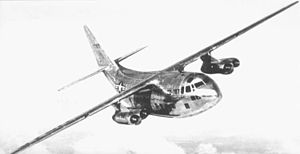The Chase XC-123A was an experimental transport aircraft developed by Chase Aircraft. The first jet-powered transport built for the United States Air Force, it was intended for use as a high-speed transport for high-priority cargo and personnel. The XC-123A was determined to have insufficient advantages over existing types in service, and did not go into production. The sole prototype was converted into the piston-powered Stroukoff YC-123D to evaluate boundary layer control systems.
| XC-123A | |
|---|---|

| |
| Role | Military transport aircraft |
| Manufacturer | Chase Aircraft |
| Designer | Michael Stroukoff |
| First flight | 21 April 1951 |
| Primary user | United States Air Force |
| Number built | 1 |
| Developed from | Chase XCG-20 |
| Career | |
| Other name(s) | Jet Avitruc |
| Serial | 47-787 |
| Fate | Converted to YC-123D 53-8068 |
In the late 1940s, Chase Aircraft had developed the XG-20, the largest glider ever built in the United States.[1] By the time it was ready for operations, however, U.S. military doctrine had been altered to remove the requirement for the use of transport gliders in combat.[2]
However, the XG-20's aircraft had been designed to allow for the easy installation of power plants, and Chase modified the two prototypes into powered aircraft, one becoming the XC-123, with twin piston engines.[3] The second XG-20, however, was taken in hand for a more radical reconfiguration, being fitted with two twin-jet engine pods, of the type used by the Convair B-36 and Boeing B-47 bombers, to become the XC-123A.[4] As there was no provision for housing fuel in the former glider's wings, fuel tanks were installed underneath the cabin floor.[4]
Dubbed "Avitruc" by its manufacturer,[5] the XC-123A conducted its maiden flight on April 21, 1951,[4] becoming the first jet-powered transport aircraft to successfully fly in the United States.[4] It was considered "excellent" in flight trials, with the aircraft showing few vices,[6] and demonstrating reasonably good short-field capability.[4]
Despite this, even as the XC-123 proved successful, the XC-123A failed to win sufficient favor in flight testing to receive a production order. Although the aircraft's short-field performance was good, on rough, unimproved fields the low-slung jet pods would suck debris into the intakes, damaging the engines.[4] In addition, the aircraft's design was mismatched to its engines,[7] resulting in the XC-123A being incapable of providing sufficient cargo capacity compared to the amount of fuel its jet engines required.[2] As a result, the XC-123A project was abandoned without additional aircraft being built.[2]
Following the conclusion of trials, the XC-123A was converted to be powered by two Pratt & Whitney R-2800 radial engines, and was used for boundary layer control trials as the Stroukoff YC-123D, receiving serial number 53–8068.[4][8][9]
Data from Gunston[6] and Adcock[4]
General characteristics
Performance
Related development
Aircraft of comparable role, configuration, and era
Related lists